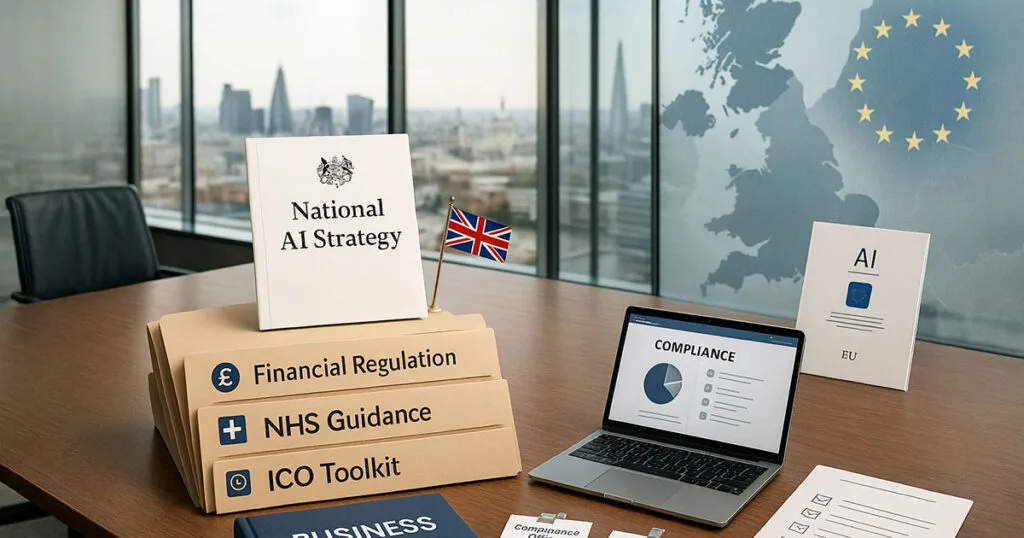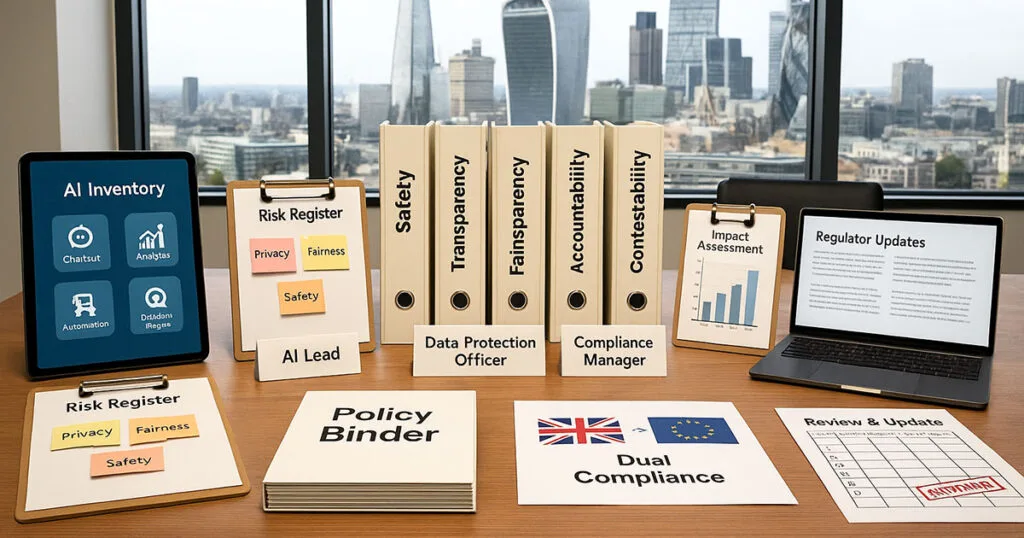TL;DR
- Every UK organisation must develop a practical AI policy now to manage risks and comply with the UK’s principles-based approach
- The UK uses five core principles (Safety, Transparency, Fairness, Accountability, Contestability) rather than prescriptive rules
- UK businesses serving EU customers face dual compliance challenges with both UK guidance and EU AI Act requirements
- Start with the ICO toolkit, Alan Turing Institute resources, and sector-specific guidance to build your framework
The UK’s ambition to become an “AI superpower” has moved from aspiration to urgent reality for every organisation. Whether you’re running a small charity, managing NHS services, or leading a fintech startup, AI policy is no longer optional; it’s essential infrastructure for operating safely in 2025.
Also, the government’s pro-innovation approach means you’re responsible for developing clear, practical guidelines to govern your use of AI. This isn’t about stifling innovation; rather, it’s about building trust, managing risks, and positioning your organisation to benefit from AI’s transformative potential while staying compliant with evolving regulations.
Unlike the EU’s prescriptive AI Act, the UK has chosen flexibility over rigid rules. This creates opportunities for innovation but places greater responsibility on organisations to interpret and apply five core principles across their AI activities. Add the Brussels Effect, where EU rules impact UK businesses serving European customers, and the compliance picture becomes more complex.
This guide explains what AI policy means in practice, why every UK organisation needs one, and how to build a framework that works for both UK and EU requirements. We’ll explore the five principles, examine real-world examples from the NHS and financial services, and provide a step-by-step approach to developing your own policy.

What is AI policy in the UK context?
AI policy in the UK is a practical framework that guides how your organisation uses artificial intelligence safely, fairly, and transparently, based on principles rather than prescriptive rules.
Key Terms in UK/EU AI Policy
- AI Policy (UK): Framework for responsible use of AI in UK organisations
- AI Governance: Oversight of AI systems for fairness, safety, and compliance
- ICO Guidance: Advice from the UK’s data regulator for AI/data protection
- EU AI Act: EU’s binding risk-based AI regulation, affecting many UK businesses
- Contestability: The right to challenge AI-driven decisions
- Brussels Effect: How EU rules influence UK business practices through market forces
- Sectoral Guidance: Regulator-specific advice (FCA, Ofcom, NHS) for different industries
- Dual Compliance: Meeting both UK principles and EU legal requirements simultaneously
The UK’s pro-innovation approach
AI policy defines the rules, processes, and responsibilities for how your organisation develops, procures, and deploys AI systems. Think of it as your rulebook for smart technology, just as you need policies for data protection or health and safety, you similarly need clear guidance for AI use.
Furthermore, the UK has chosen a unique “pro-innovation” approach that differs markedly from other jurisdictions. Rather than creating new, rigid legislation, the government published a White Paper in March 2023, establishing five cross-sectoral principles that existing regulators can interpret within their respective domains.
Understanding the five core principles
These five principles form the backbone of UK AI policy:
Safety, Security and Robustness: AI systems must function reliably throughout their lifecycle. This means identifying risks, testing thoroughly, and ensuring systems perform as intended without causing unintended harm.
Appropriate Transparency and Explainability: Users and affected parties must understand how AI systems work and make decisions. The level of explanation should match the risk—a chatbot needs less explanation than medical diagnostic AI.
Fairness: AI must not undermine legal rights, create discriminatory outcomes, or establish unfair market conditions. This connects directly to the Equality Act 2010 and Human Rights Act 1998.
Accountability and Governance: Clear lines of responsibility must exist throughout the AI lifecycle. When multiple parties are involved, data providers, model developers, deployers, everyone must know their role.
Contestability and redress: When AI causes harm or creates material risk, there must be clear routes for challenge and appeal. People affected by AI decisions need accessible ways to dispute outcomes.
How regulators apply these principles
This sector-led model empowers regulators like the ICO, FCA, and Ofcom to apply these principles using their existing expertise and legal powers. The ICO has emerged as the de facto lead AI regulator because data protection law touches virtually every AI system.
A common misconception is that AI policy is “just GDPR.” While data protection is crucial, AI policy addresses broader ethical, safety, and fairness considerations that extend beyond personal data to algorithmic decision-making, bias prevention, and human oversight.

Why does your organisation need this framework in 2025?
Without proper AI policy, UK organisations face legal penalties, reputational damage, and missed opportunities in an increasingly AI-driven economy where trust is the key differentiator.
Legal and regulatory risks
The regulatory landscape has shifted dramatically. The ICO can impose fines up to £17.5 million or 4% of global turnover for data protection breaches involving AI. Similarly, the FCA expects financial firms to maintain robust governance for AI systems under existing rules. Additionally, Ofcom regulates AI-generated content under the Online Safety Act.
Furthermore, reputational risks are equally severe. Public trust in AI remains fragile, with citizens expressing strong concerns about over-reliance on technology and loss of individual autonomy. Thus, high-profile AI failures, from biased recruitment tools to inaccurate medical diagnoses, demonstrate how quickly things can go wrong without proper governance.
The dual compliance challenge
The dual compliance challenge adds complexity. UK businesses serving EU customers must navigate both the UK’s flexible framework and the EU AI Act’s prescriptive requirements. The Brussels Effect means many UK firms adopt EU standards as their global baseline, potentially limiting the practical impact of the UK’s regulatory divergence.
Key drivers for action
Several drivers make AI policy essential in 2025:
Procurement Requirements: Public sector contracts increasingly require AI governance frameworks. The NHS mandates Data Protection Impact Assessments for all AI implementations. Local councils demand transparency about algorithmic decision-making in housing allocation and social services.
Funding and Investment: Investors expect robust AI governance before backing startups. Grant applications require evidence of responsible AI practices. The government’s AI Opportunities Action Plan prioritises organisations demonstrating strong ethical frameworks.
Operational Excellence: Well-governed AI delivers better outcomes. Financial firms using AI for fraud detection report improved accuracy when human oversight and bias testing are embedded. NHS trusts with clear AI protocols experience faster implementation and higher clinician adoption.
Real-world examples
Real-world examples illustrate these benefits. Dorset Council’s AI-powered acoustic monitoring in care homes required careful policy development to balance innovation with privacy rights. Gloucestershire NHS Trust’s AI system for predicting long hospital stays needed transparent governance to build clinician trust. Swindon Borough Council’s generative AI for Easy-Read documents demanded clear accountability measures.
The cost of inaction is rising. A 2025 Public Accounts Committee report highlighted how poor AI governance risks undermining public service delivery and citizen trust. Financial firms without robust AI frameworks face increased regulatory scrutiny and potential enforcement action.

The five principles that guide responsible AI use
The five UK principles translate into specific, measurable actions that organisations must embed throughout their AI lifecycle, from procurement to deployment and ongoing monitoring.
Safety and security in practice
Safety, security and robustness require continuous risk management. NHS AI systems undergo rigorous testing before deployment, with ongoing monitoring for accuracy drift. Similarly, financial firms implement “human-in-the-loop” controls for high-stakes decisions like loan approvals. Moreover, this principle maps to existing legal duties under health and safety legislation and operational resilience requirements.
Additionally, the ICO’s guidance emphasises that safety isn’t just about technical functionality, it includes protecting individuals from discrimination, manipulation, and privacy violations. Thus, organisations must conduct AI impact assessments, implement security measures against adversarial attacks, and maintain audit trails of system performance.
Transparency and explainability requirements
Appropriate transparency and explainability varies by context and risk. Consumer-facing AI like recommendation systems need clear privacy notices explaining data use. In contrast, medical AI requires detailed explanations clinicians can understand and communicate to patients. Similarly, financial AI must meet Consumer Duty requirements for clear, fair communication.
Furthermore, the FCA maps this principle to existing rules requiring firms to communicate clearly with customers. Meanwhile, Ofcom applies it through broadcasting codes requiring transparency about AI-generated content. Importantly, the key is proportionality; explanation depth should match the impact on individuals.
Ensuring fairness and non-discrimination
Fairness connects directly to equality legislation. AI systems must not discriminate against protected characteristics or create unfair advantages. This requires testing for bias in training data, ongoing monitoring of outcomes across different groups, and corrective action when unfairness is detected.
Local government provides clear examples. Housing allocation algorithms must demonstrate fair treatment across ethnic groups. Social services AI cannot disadvantage families based on postcode or family structure. The Equality Act 2010 applies fully to AI-driven decisions.
Accountability and clear governance
Accountability and governance establishes clear ownership. The FCA’s Senior Managers Regime ensures individual accountability for AI decisions in financial services. NHS trusts designate responsible officers for each AI system. Data Protection Officers often assume AI governance roles due to their expertise in risk assessment and compliance.
This principle requires documented decision-making processes, clear escalation routes when things go wrong, and regular review cycles. Organisations must know who is responsible at each stage of the AI lifecycle.
Rights to challenge and appeal
Contestability and redress ensure people can challenge AI decisions affecting them. This might involve human review of automated decisions, appeals processes, or access to ombudsman services. The principle builds on existing consumer protection and administrative justice frameworks.
Financial services provide established models through the Financial Ombudsman Service. Public sector decisions already have judicial review routes. The challenge is ensuring these mechanisms work effectively for AI-driven decisions.

Understanding different governance approaches
AI policy operates at three levels, national strategy, sectoral guidance, and organisational frameworks, with the UK’s flexible model contrasting sharply with the EU’s unified approach.
The three levels of governance
Understanding these different layers helps organisations position their own policies effectively within the broader governance landscape.
National policy sets strategic direction. The UK’s 2021 National AI Strategy established the “AI superpower” ambition, while the 2025 AI Opportunities Action Plan focuses on infrastructure investment. These documents guide government priorities and funding, but don’t create direct legal obligations for private organisations.
The Department for Science, Innovation and Technology coordinates national policy, while the AI Security Institute leads on safety research and standards. This strategic layer influences sectoral guidance and international negotiations but leaves implementation to specialist regulators.
Sectoral Implementation
Sectoral Policy provides practical guidance. The ICO’s AI toolkit helps organisations conduct risk assessments. The FCA’s guidance maps AI risks to existing financial regulations. Ofcom’s approach focuses on content safety and platform responsibilities. NHS guidance covers clinical AI applications and patient safety.
This sector-led model reflects the UK’s preference for regulatory flexibility. Each regulator applies the five principles using their existing expertise and legal powers. The Digital Regulation Cooperation Forum coordinates between regulators to prevent gaps or contradictions.
Organisational frameworks
Organisational Policies translate principles into practice. These internal frameworks define how individual organisations use AI, assign responsibilities, and manage risks. They must align with relevant sectoral guidance while addressing specific business contexts and risk profiles.
Public sector organisations often start with the government’s AI Playbook and Data Ethics Framework. Private sector firms adapt guidance from their primary regulator, the ICO for data processing, FCA for financial services, Ofcom for communications.
Sector-specific examples
Sector-specific approaches reflect different risk profiles and regulatory maturity:
The NHS requires Data Protection Impact Assessments for all AI implementations, with additional clinical governance for diagnostic systems. Local councils focus on transparency and fairness in algorithmic decision-making for services like housing allocation.
Financial services firms integrate AI governance into existing risk management frameworks. The FCA expects Consumer Duty compliance, operational resilience measures, and Senior Manager accountability. Many firms establish AI steering committees and dedicated risk functions.
Charities and SMEs often start with simpler frameworks, focusing on core data protection and fairness requirements. The ICO provides scaled guidance for smaller organisations with limited resources.
UK vs EU Comparison
UK vs EU Comparison highlights fundamental differences. The EU AI Act creates binding legal obligations based on system risk classifications. High-risk systems face extensive requirements, including conformity assessments, technical documentation, and post-market monitoring.
UK organisations serving EU customers face dual compliance challenges. They must satisfy both UK principles and EU prescriptive requirements. Many adopt EU standards as their global baseline to simplify compliance, potentially limiting the UK’s regulatory advantage.
The Brussels Effect means EU rules influence UK practice even when not legally required, as businesses choose higher standards to maintain market access.

Seven steps to build your governance framework
Building effective AI policy requires a systematic seven-step approach that aligns with UK principles while addressing your organisation’s specific risks and opportunities.
Steps 1-2: Scope and risk assessment
Step 1: Define the Scope. Identify all AI systems your organisation uses or plans to implement. This includes obvious applications like chatbots and recommendation engines, plus less visible systems like automated decision-making tools, predictive analytics, and AI-enhanced software.
Additionally, create an AI inventory covering purchased systems, developed solutions, and planned implementations. Consider the entire lifecycle from data collection through model training to deployment and monitoring. Furthermore, don’t forget AI embedded in third-party software or cloud services.
Step 2: Map risks and opportunities. Assess potential impacts on individuals, communities, and your organisation. Consider data privacy implications under UK GDPR, fairness risks affecting protected characteristics, safety concerns in high-stakes applications, and transparency requirements for affected users.
Additionally, use the ICO’s AI Risk Toolkit to structure this assessment. When considering sectoral requirements, NHS organisations must evaluate clinical safety, financial firms assess consumer outcomes, and public bodies examine equality impacts.
Steps 3-4: Roles and principles
Step 3: Assign Roles. Establish clear accountability for AI governance. Designate senior executives responsible for AI strategy and oversight. Assign operational roles for risk assessment, system monitoring, and incident response.
Data Protection Officers often lead AI governance due to their expertise in risk assessment. Technical teams handle implementation and monitoring. Legal and compliance functions ensure regulatory alignment. Create cross-functional AI steering committees for major implementations.
Step 4: Align with Five Principles. Structure your policy around Safety, Transparency, Fairness, Accountability, and Contestability. Define specific requirements for each principle relevant to your context.
Safety might include testing procedures, human oversight requirements, and incident response plans. Transparency could cover user notifications, decision explanations, and documentation standards. Fairness requires bias testing, outcome monitoring, and corrective action procedures.
Steps 5-7: Documentation and Compliance
Step 5: Document Procedures. Create clear processes for AI system assessment, approval, deployment, and ongoing monitoring. Include templates for impact assessments, risk registers, audit trails, and incident response procedures using resources like the ICO’s AI toolkit and risk assessment tools.
Establish review cycles for system performance, accuracy monitoring, and policy updates. Define escalation procedures when systems underperform or cause harm. Maintain detailed audit trails for all AI decisions and ensure documentation meets potential regulatory audit requirements.
Step 6: Review and Update Regularly. AI technology and regulation change rapidly. Schedule quarterly reviews of system performance and annual policy updates. Monitor guidance from relevant regulators and adjust procedures accordingly.
Subscribe to updates from the ICO, your sectoral regulator, and the Alan Turing Institute’s governance workbooks. Participate in industry forums and professional networks to share best practices and early warnings about emerging risks.
Step 7: Check for Dual Compliance. If you serve EU customers or operate in EU markets, map your processes to both UK and EU requirements. The EU AI Act may require additional documentation, conformity assessments, or technical measures for high-risk systems.
Consider adopting EU standards as your global baseline if compliance costs outweigh the benefits of separate frameworks. Seek legal advice on the extraterritorial application of EU rules to your specific circumstances.
Getting support
Resources and support include the ICO’s AI toolkit and guidance documents, the government’s AI Playbook and Data Ethics Framework, and sector-specific guidance from your primary regulator.

What’s coming next in UK AI regulation
The UK’s AI policy landscape is moving towards a hybrid model combining current flexibility with targeted legislation for high-risk systems, while EU influence continues growing through market forces.
Potential new legislation
Potential Legislation represents the most significant upcoming change. The government has shifted from rejecting new AI laws to promising “appropriate legislation” for the most powerful AI models. Private Members’ Bills in Parliament propose creating a central AI Authority and mandating impact assessments.
This hybrid approach would retain sectoral flexibility for most applications while introducing binding requirements for foundation models and high-risk systems. The change reflects concerns about regulatory fragmentation and the need for international credibility alongside EU and US legislation.
AI security focus
AI security institute expansion signals the UK’s strategic focus on technical governance. The Institute’s transformation from advisory body to independent statutory authority reflects growing attention to national security implications of AI, including malicious use for weapons development and cyberattacks.
This change builds on the UK’s cybersecurity expertise and close intelligence relationships, particularly with the United States. Expect increased focus on AI system security, resilience testing, and international standards development.
The growing assurance market and preparing for changes
Growing Assurance Market responds to increasing demand for AI auditing and evaluation services. The concept of “AI Assurance”, frameworks for measuring and promoting trustworthy AI, is becoming central to UK governance.
New market opportunities are emerging in AI testing, bias detection, explainability services, and compliance monitoring. Meanwhile, professional services firms are developing AI governance capabilities. Additionally, technology vendors are building assurance tools into their platforms.
Preparing for Changes involves several strategic considerations. International coordination continues through the Global Partnership on AI, UK-US collaboration on AI safety, and engagement with EU regulatory development. Furthermore, the UK aims to shape international standards while maintaining a competitive advantage through regulatory flexibility.
Preparation strategies for organisations include monitoring policy consultations and regulatory updates, building relationships with sectoral regulators and professional bodies, investing in AI governance capabilities and staff training, and developing flexible frameworks that can adapt to new requirements.
Thus, consider joining industry working groups on AI governance, participating in regulator engagement programmes, and building internal expertise in AI risk management and compliance.
This means dual compliance changes will likely intensify as the EU AI Act takes full effect and the UK potentially introduces new legislation. Organisations should prepare for more complex compliance landscapes requiring sophisticated risk management and legal expertise.
Ultimately, the Brussels Effect will continue influencing UK practice regardless of formal regulatory differences, as businesses choose global standards over multiple compliance frameworks.

Your next steps forward
AI policy has moved from a theoretical concern to a practical necessity for every UK organisation. Furthermore, the government’s pro-innovation approach creates opportunities for competitive advantage but places responsibility on organisations to interpret and apply five core principles across their AI activities.
Thus, starting your AI policy journey today positions your organisation for success in an increasingly regulated environment. Use official UK resources to build frameworks that protect reputation, ensure compliance, and enable innovation.
Additionally, the dual compliance challenge with EU regulations adds complexity but also opportunity. Organisations with robust governance frameworks can compete globally while maintaining the flexibility that makes the UK attractive for AI development.
Additionally, regular review and adaptation are essential as technology and regulation continue changing. This means the investment in AI governance today becomes a competitive advantage tomorrow, building trust with customers, regulators, and stakeholders while enabling safe adoption of transformative technology.
Take Action Today: If you need sector-specific examples or help getting started, contact your regulator or reach out to us at Insightful AI. The sooner you act, the better protected your organisation will be in our rapidly advancing AI-driven economy.
Remember: This guidance provides general information only and should not be considered legal advice. Always consult official resources and seek professional legal guidance for your specific circumstances.




